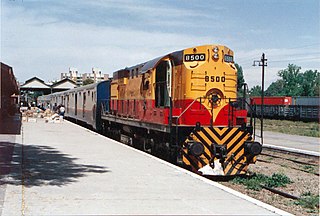
Ferrocarriles Argentinos was a state-owned company that managed the entire Argentine railway system for nearly 45 years. It was formed in 1948 when all the private railway companies were nationalised during Juan Perón's first presidential term, and transformed into the Empresa de Ferrocarriles del Estado Argentino.
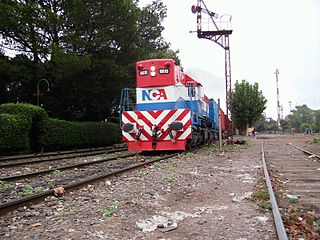
Nuevo Central Argentino S. A. is an Argentine company that utilises the operation and infrastructure of the national railway system of the former Mitre Railway division of Ferrocarriles Argentinos, by a concession granted on 23 December 1992 as part of railway privatisation carried out during the presidency of Carlos Menem.

The General Roca Railway (FCGR) is a 5 ft 6 in broad gauge railway in Argentina which runs from Constitución station in Buenos Aires to the south of the country through the provinces of Buenos Aires, La Pampa, Neuquén and Río Negro. It was also one of the six state-owned Argentine railway divisions formed after President Juan Perón's nationalisation of the railway network in 1948, being named after former president Julio Argentino Roca. The six companies were managed by Ferrocarriles Argentinos which was later broken up during the process of railway privatisation beginning in 1991 during Carlos Menem's presidency.

The General Bartolomé Mitre Railway (FCGBM), named after the former Argentine president Bartolomé Mitre, is one of the six state-owned Argentine railway lines formed after President Juan Perón's nationalisation of the railway network in 1948 and one of the largest of Argentina. The six divisions, managed by Ferrocarriles Argentinos were later broken up during the process of railway privatisation beginning in 1991 during Carlos Menem's presidency.
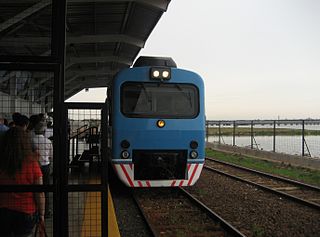
The General Urquiza Railway (FCGU), named after the Argentine general and politician Justo José de Urquiza, is a standard gauge railway of Argentina which runs approximately northwards from Buenos Aires to Posadas, with several branches in between. It was also one of the six state-owned Argentine railway companies formed after President Juan Perón's nationalisation of the railway network in 1948. The six companies were managed by Ferrocarriles Argentinos which was later broken up during the process of railway privatisation beginning in 1991 during Carlos Menem's presidency.

The General Manuel Belgrano Railway (FCGMB), named after the Argentine politician and military leader Manuel Belgrano, is a 1,000 mmmetre gauge railway and the longest of the Argentine system. It was one of the six State-owned Argentine railway companies formed after President Juan Perón's nationalisation of the railway network in 1948.

The General San Martín Railway (FCGSM), named after the former Argentine general José de San Martín, was one of the six state-owned Argentine railway companies formed after President Juan Perón's nationalisation of the railway network in 1948. The six companies were managed by Ferrocarriles Argentinos which was later broken up during the process of railway privatisation beginning in 1991 during Carlos Menem's presidency.
In Argentina, State-owned railway companies run both, passenger and freight services within the country. The first State-owned company was Argentine State Railway, formed in October 1909 while José Figueroa Alcorta was President of Argentina.

The Buenos Aires Midland Railway (BAM) was a British-owned railway company which operated in Argentina, where it was known as Ferrocarril Midland de Buenos Aires. The company built and operated the 1,000 mm gauge line between Puente Alsina and Carhué in Buenos Aires Province.

The San Martín line is a 70-kilometre (43 mi), 22-station commuter rail service in the metropolitan area of Buenos Aires, Argentina. The San Martín line operates from the city-centre terminus of Retiro north-west to Doctor Cabred in Luján Partido along a broad gauge line built by the British-owned Buenos Aires and Pacific Railway.

Railway privatisation in Argentina was a process which began in 1993 under the presidency of Carlos Menem, following a series of neoliberal economic reforms. This primarily consisted of breaking up the state-owned railway company Ferrocarriles Argentinos (FA) and allowing the former lines to be operated by private companies instead of the state. This policy was met with widespread criticism and proved catastrophic for the Argentine railways whose service worsened significantly in the years that followed, with entire lines closing and infrastructure deteriorating beyond repair. Privatisation was ultimately reversed in 2015 with the creation of Nuevos Ferrocarriles Argentinos.
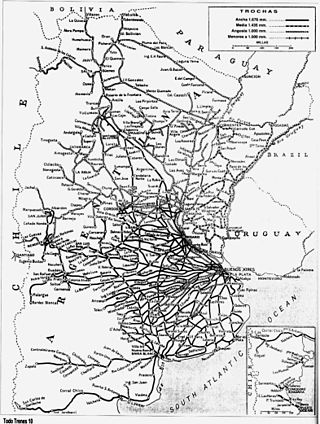
The Argentine railway network consisted of a 47,000 km (29,204 mi) network at the end of the Second World War and was, in its time, one of the most extensive and prosperous in the world. However, with the increase in highway construction, there followed a sharp decline in railway profitability, leading to the break-up in 1993 of Ferrocarriles Argentinos (FA), the state railroad corporation. During the period following privatisation, private and provincial railway companies were created and resurrected some of the major passenger routes that FA once operated.

The EMD G22CU is a metre gauge diesel-electric locomotive designed and built by the Electro-Motive Division of General Motors. It was manufactured by several licensees, and exported to many countries including Argentina, Australia, Brazil, Egypt, Iran, New Zealand, Nigeria, Pakistan, South Korea, Yugoslavia and Taiwan (ROC).
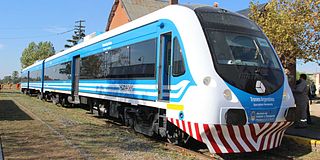
Materfer is an Argentine manufacturer of railway and road vehicles, located in the city of Ferreyra in Córdoba Province. The company was established by Fiat Concord in the late 1950s, being its subsidiary until 1980 when Sevel Argentina took over Fiat vehicles.

Tucumán is a train station in the city of San Miguel de Tucumán of Tucumán Province, Argentina, and terminus of Ferrocarril Mitre.

The CNR CKD8 is a 2,949 hp (2.2 MW) diesel-electric locomotive manufactured by China CNR Corporation from 2013 onwards for use in Argentina by state-owned Trenes Argentinos, a subsidiary of Ferrocarriles Argentinos S.E. The CKD8G variant is used primarily on the Roca and Sarmiento railways, while the faster CKD8H is used on the San Martín and Mitre railways.
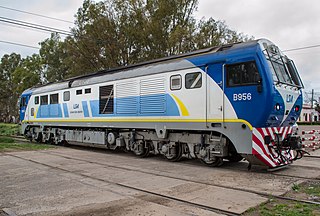
The CSR SDD7 is a 2,249 hp diesel-electric locomotive manufactured by CSR Corporation Limited from 2013 onwards for use in Argentina by Trenes Argentinos, a subsidiary of Ferrocarriles Argentinos S.E. On the San Martín Line in Buenos Aires Province, 24 of these locomotives are used, making up the entire rolling stock of the commuter rail line.
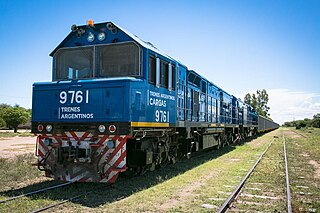
Belgrano Cargas y Logística S.A., trading as Trenes Argentinos Cargas, is an Argentine State-owned company which operates a 15,305 km (9,510 mi) freight rail network that includes Belgrano, Urquiza and San Martín railways. It is a subsidiary of Trenes Argentinos.

The Capilla del Señor Historic Train was a heritage railway of Buenos Aires Province in Argentina. The service ran trains pulled by steam locomotives between the cities of Buenos Aires and Capilla del Señor, covering a distance of 86 km (53 mi). Trains ran on 1,435 mm tracks originally built by the Buenos Aires Central Railway and currently part of General Urquiza Railway since the railway nationalisation of 1948.

The 7131 was an Argentine diesel multiple unit class, first produced in Italy by Fiat Ferroviaria, then licensed to Argentine company Materfer to continue the manufacturing. Those railcars were introduced in the 1960s to replace the existing rolling stock of most of the urban services of Argentina, such as Roca, Urquiza, Mitre and Sarmiento lines.





















